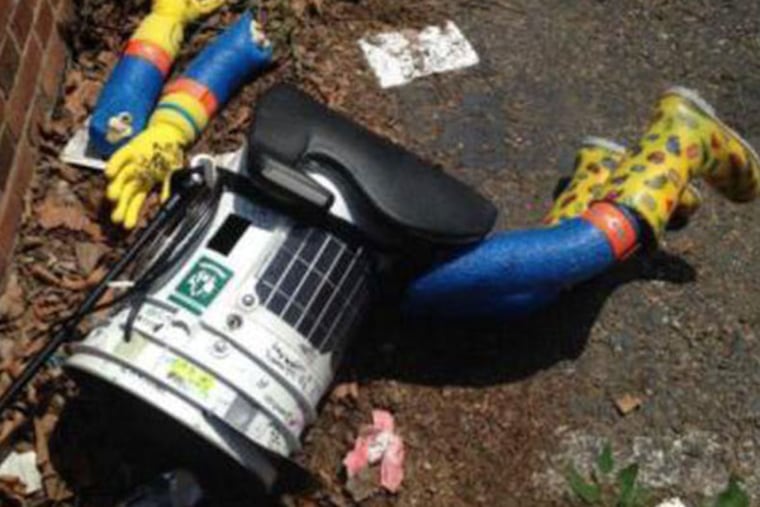When we all become part of a big experiment
By Dominic A. Sisti and Arthur Caplan HitchBOT died in Philadelphia. The initial suspect was - wait for it - an Eagles fan. But that was a hoax. We may never know what happened.

By Dominic A. Sisti
and Arthur Caplan
HitchBOT died in Philadelphia. The initial suspect was - wait for it - an Eagles fan. But that was a hoax. We may never know what happened.
In its short life, the little robot got to sit in the cockpit of an Air Canada plane, visited Dutch art galleries, and met Santa Claus - never a good credential to bring to Philadelphia for reasons that all local sports fans know all too well. Now, having brought the hitchhiking robot to a gruesome denouement, however it occurred, Philadelphia must yet again bear the scorn of the planet for the hostility of its residents to all outsiders, human and otherwise.
The destruction of hitchBOT has occasioned diverse reactions, from the absurdly proud (radio host Angelo Cataldi) to the pathetically sad (most of the world). Certainly, the wanton destruction of private property is not laudable.
But hitchBOT was more than just property and high technology. It was a research tool designed and deployed by professors from two major research universities in Canada. The robot was a test. But the experiment appears to have lacked a normal informed consent process. Is that why hitchBOT needed to die?
The goal of the hitchBOT program was, in the words of designers Frauke Zeller and David Harris Smith, an "artwork and social robotics experiment." As such, one would expect them to collect hitchBOT's data set, analyze it, and then publish their findings. HitchBOT was therefore a scientific experiment, and everyone who came in contact with it a potential research subject.
The designers fashioned hitchBOT to charm and entice people to take it along on car rides, to meals, to weddings, and on airplanes. These people became research participants whether they knew it or not. This alone raises some interesting ethical questions. Did hitchBOT's designers get approval from an institutional review board in their home institutions? And moreover, since this is a global project, should the investigators have sought approval from other nations before sending it out into a potentially cruel world?
We know very little of the way the ethics of this program were handled. For example, were people roped in by hitchBOT's intentional cuteness to become willing participants? Did they have an opportunity to give informed consent before loading the contraption into their cars and bringing it into their lives? Were they debriefed by the researchers or hitchBOT himself after they separated?
It's true that low-risk social science research programs are often deemed exempt from regulatory scrutiny. But is hitchBOT low risk? If its destruction has caused serious grief to past participants, or stigma to an entire city deemed responsible for its demise, shouldn't this have been considered by its developers?
One big ethical question is whether there are unpleasant facts about humanity that we would all rather not know. Such knowledge might be related to blind obedience to authority, as in the famous Milgram experiments in which people shocked fake subjects to death, or the transformation of individuals into sadistic bullies in the notorious Stanford prison experiment. Although most of what hitchBOT recorded was general kindness, does its fateful ending reveal something about humanity (or maybe just Philadelphians) we'd rather not know? How much snickering can Philadelphians be expected to endure, even in the name of science?
A criminal justice professor from American University stated in his postmortem on the robot that "violence is kind of an expression . . . which you don't find in Canada." OK. But is a single case the kind of evidence one would wish to use to support such a broad finding? Sociologist Jeff Feller claimed, "Culturally, there's sort of a meanness in the American soul that isn't present in Canada and other places, so in some ways I found it too typical." Really? These sound like gross stereotypes based on little evidence and a lot of hype, overlooking the outpouring of kindness bestowed upon this trashcan with a smartphone brain.
Perhaps hitchBOT's assailant was a concerned ethics board member, disturbed by the unwelcome recruitment and surveillance of members of his city. More likely it was an intoxicated Eagles fan who took the little guy for a Cowboys fan. Or maybe it was someone just offended by the saccharine appearance of hitchBOT. Cuteness never goes over well in Philly.
Arthur Caplan is director of the Division of Medical Ethics at New York University's Langone Medical Center department of population health. arthur.caplan@nyumc.org